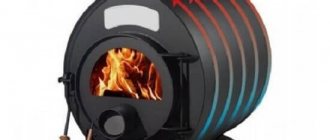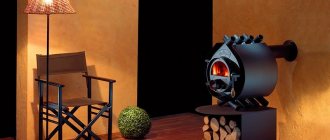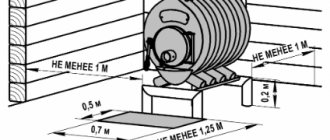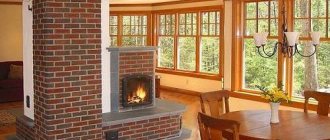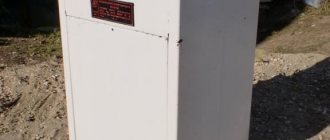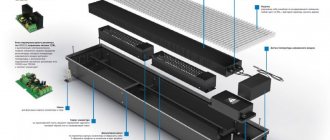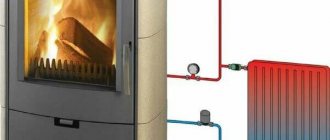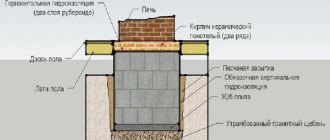The name “Buleryan” (also known as buller, bullerjan, buller, breneran) has already become a household name. If “Buleryan stoves” means “warm, long-lasting and economical.” There is a lot of information on the Internet about these miracle stoves - they write about their high efficiency, their surprisingly long burning time (more than 12 hours) and, as a result, their efficiency. In this article we will figure out whether these stoves are as good as they are said to be. Let's see what the real pros and cons of these stoves are and in which cases it will be a good purchase, and in which it is better to wait.
Main characteristics of Buleryan stoves
The stove resembles a classic “potbelly stove” in appearance and the principle of using fuel, but that’s where the similarities end. The unit is equipped with air ducts, thanks to which the efficiency of the portable stove is about 85%.
There are two more differences in appearance: the product can be teardrop-shaped, intended for heating large rooms, and round, for heating small rooms; moreover, it consists of a larger number of elements.
Classic bullers consist of:
- Compartment for burning fuel (it occupies more than 4/5 of the total volume of the product, primary ignition occurs in it);
- The second compartment, the volume of which is equal to the remaining 1/5, is used for afterburning fuel;
- Both compartments are connected to each other by narrow injector tubes, and large pipes at the bottom and top of the structure act as air ducts: cold air enters through the lower ones, and warm air masses enter the heating system from the upper ones;
- The design also contains elements inherent in any stove: a chimney, an ash pan, a choke and a damper.
The buller is not such a complicated product - it is quite possible to make it yourself, but you will have to do the work very painstakingly. In addition, the master must have good welding skills.
Design and mechanism of operation
The Buleryan stove consists of a barrel-shaped body, the internal space of which is divided into two sections. The process of kindling and burning wood occurs in the lower part, this is where the temperature begins to rise and heat accumulates. At the same time, as the wood burns out, hot gases accumulate in the upper part of the body.
Radius pipes pass through the center of both parts of the furnace, in which convection occurs. Cold air, entering the furnace through the pipes, encounters a hot circuit, which creates a fast flow that rushes out and carries away the heat of the furnace. The basic principle of operation of the device is the correct combination of several heating options, including: convection, heat transfer and heat exchange. Due to the lack of a ventilation system, heating thus occurs quite quickly.
How Buleryan works
The device works quite simply: the required volume of firewood is loaded into the firebox, lit, and then the access of air into the chamber is limited. As a result, the fuel does not burn out instantly, but smolders slowly.
- Combustion products enter the second compartment in the form of flammable gas, it ignites, and the generated heat enters the room.
- When making a buller yourself, in addition to accurately connecting the elements, you need to accurately calculate the power of the device.
- Then it will be possible to add fuel only two or three times a day.
Buleryan belongs to the category of long-burning stoves and can operate in two modes: kindling and gasification.
In the first case, the main task will be to heat the device to a temperature of 800°. This is done simply: light the fuel, close the firebox door, and open the damper completely. At the exit, the temperature of the air masses reaches about 140°, and the room quickly warms up.
- In this method, the stove has low efficiency and high fuel consumption. It is for this reason that Buleryan is switched to gasification mode after about thirty minutes.
- During this time, the first batch of firewood burns out. Next, a second batch of firewood is placed in the chamber, and they are stacked as tightly as possible, and the gaps between them are filled with sawdust. After this, the door closes and the air flow is limited by the damper.
- In this mode, the fuel slowly smolders, releasing gas, which burns out in the second chamber. With a dense load of fuel, the boiler can work without additional filling for about twelve hours - everything will depend on the type of wood: the harder it is, the longer the stove will work without filling.
Until recently, boilers were used to heat one room. Now there are Buleryan water stoves (models with a water circuit) - aquabullers, they are used to heat several rooms or floors, but such a device is not in particular demand.
Models
Buleryan heating stoves are produced by different factories in different countries. There is a plant in Ukraine. They produce heating “Bullers” and sauna stoves; there are also heat accumulators compatible with some models.
Ukrainian version. "Bullers"
The technical characteristics of Buleryan convection ovens manufacturer are summarized in the table.
Technical characteristics of Ukrainian-made Buleryanov (click to enlarge picture)
Thermal accumulators are used mostly in greenhouses, where there are almost no walls that accumulate heat in conventional buildings. The hinged panels are made of painted steel plates and completely follow the shape of the stove, so each modification has its own heat accumulator. The device is hung on the tops of the heat exchange pipes and rests on their lower ends. They can be filled with any solid heat-intensive material: broken brick, large crushed stone, pebbles, etc.
Canadian Bulerjan. Models of different power
Canadian Buleryan stoves are also represented in Russia. Their characteristics are summarized in the table. As you can see, the design is different, but the characteristics are the same.
Canadian Bulerjan. Technical specifications (click to enlarge image size)
Advantages of the Buleryan stove
Of course, this device has its pros and cons, and there are still more of the former, otherwise the device would hardly have become so popular.
The positive aspects include:
- High performance;
- Device mobility;
- Ease of operation;
- Possibility of using several types of fuel;
- Independence from communications;
- Safety – it is almost impossible to get burned by a buller operating in gasification mode;
- Cost-effective - one device can replace three: a conventional oven, a gas generator and a heater.
Based on reviews of the Buleryan stove, it is clear that users include the following as disadvantages:
- The need to use dry fuel;
- Formation of highly toxic condensate inside the chimney;
- The inevitable presence of a burning smell;
- The need to construct chimneys with a height of 5 to 7.5 meters.
A little history
In Canada, forests are felled not in blocks, but selectively, and teams of lumberjacks lead a nomadic lifestyle. Logging is carried out more in the cold season, when the vegetation does not vegetate, life in the forest comes to a standstill and the damage to forest biocenoses from logging is minimal.
The climate in the Canadian taiga is even harsher than the Siberian one, and even with a 4-hour shift, workers froze into icicles. Comfort and civilization in general in the wilderness is zero. Therefore, lumberjacks needed a heating stove that could be carried with them without cluttering the body, and could be carried into a residential trailer by hand. And this stove was supposed to heat up a housing of 20-30 cubic meters in a maximum of 20 minutes. Waste fuel: branches, wood chips. The firebox is large enough to fit pieces of thick, gnarled logs into it. Operating time from one fill of fuel is at least 8 hours. Where to get up at night and heat it up, when during the day your bones have been broken to the point of pain.
Depending on the weather and season, the heating power must be adjusted. The adjustment should be simple so that it can be performed by an untrained person or after a one-time introductory briefing.
At the same time, the stove had to be inexpensive and quite technologically advanced. Electronics requiring power supply, and automation in general, were excluded: the slightest breakdown in the taiga could cost the lives of an entire brigade. The use of expensive and special equipment-requiring special alloys was also excluded: Buleryan had to be available for production in any mechanical repair shop.
Additional requirements were put forward for operational safety. Firstly, the formation of waste must be excluded under any combustion mode and under any regulations of regulatory authorities. Secondly, the body temperature of the stove should not exceed 60-70 degrees, so that if you accidentally bump into it while asleep and “out of a hangover,” you will not get burned to the point of losing your ability to work. They say that Canadian lumberjacks know how to distill moonshine from pine cones. It's called sterno.
Manufacturing principles
It is quite understandable to want to try to make a buleryan oven with your own hands. You should immediately take into account that trying to build a furnace without experience in welding and plumbing is pointless. Even though a detailed description and drawing of the Buleryan stove can be easily found on the Internet.
If such a decision is nevertheless made, it is worth remembering that in a buleryan one of the most complex elements is the front wall with the door: the latter must ensure complete sealing, and its production will have to be ordered, otherwise you will not have to count on high-quality operation of the stove.
A list of necessary materials and tools can also be found on a specialized website or forum for stove makers.
Installation rules
How to install Buleryan in garages? There are usually two main questions asked:
Where is the best place to put the stove in the garage?
It is best to place Buleryan as close to the center as possible so that no obstacles interfere with air circulation. There must be a free space of at least 1.25 meters in front of the combustion door.
Installation example (below are some more options)
What should you consider when venting the chimney outside?
Installation of the chimney is carried out subject to the following requirements:
- It should be insulated;
- When laying it through floors and roofs made of flammable materials, fire-resistant cuts are installed in the hole;
- Its head must be raised half a meter above the roof level;
- Its head should be equipped with a spark arrestor and deflector.
Methods for removing the Buleryan chimney pipe
Photos of installation options for Buleryan in the garage:
Option 1
Option 2
Option 3
Fire safety standards
According to fire safety requirements, the Buleryan stove should be installed at a distance:
- From 1 meter from wooden walls;
- Half a meter from walls insulated with thermal insulation;
- From 70 cm from plastered walls;
- From 50 cm from a single and from 30 cm from a double brick wall.
Exploitation
In order for the heating system to operate with maximum heat transfer, the instructions must be strictly followed.
Reasons for low performance may include:
- Insufficient chimney height;
- Illiterate installation of the stove (the distance from the floor is acceptable within 40-50 centimeters);
- Too many connected heating radiators (the oven should not operate at maximum).
To prevent the circuit from defrosting, it is necessary to completely drain the water from the system after finishing work.
Since the buler was originally developed for heating the living quarters of lumberjacks, the ideal fuel would be firewood - dry, hardwood. It is desirable that these are solid logs with a size corresponding to the length of the fuel chamber. Coal can be used as fuel, but is not recommended.
The firebox door must be tightly closed during operation - no gaps are allowed. Ash should remain in the firebox the entire time the stove is operating.
As already mentioned, the product has several names, although in essence it is the same device. Buleryan was renamed by the official manufacturer about fifteen years ago, due to the introduction of some improvements to the original design. As a result, the warranty period for the device has increased to two and a half years.
What to look for when choosing
Before purchasing a stove, it is necessary to determine the volume of the room for heating which it will be used. It is better to purchase a product whose power exceeds the minimum required.
When choosing, there are a number of factors to consider:
- type of hatch for loading fuel. The oven door can be made in 3 options - all-metal, cast iron, with built-in glass. From an aesthetic point of view, it is better to choose a product whose hatch is equipped with an observation window. Manufacturers use heat-resistant glass. Thanks to this, the window does not collapse even with strong heat;
- type of draft control damper lever. Some manufacturers equip the damper control handle with an extension. In such models, adjustments do not require going to the back wall of the oven;
- presence of a hob. The stove can be manufactured in 2 versions - classic or with a built-in cooking surface. The Buleryan cooker does not differ in its characteristics from the classic model. If the stove will be used not only for heating the room, but also for cooking, you can choose a model with a built-in surface;
- a method of adjusting the amount of air supplied to the firebox. The blower hatch can be made of a damper or a latch located on the door body in the form of a butterfly. The choice is made based on the person’s personal preferences;
- protective screen. Some models have a casing on the side surfaces. It is used to protect against burns when touching Buleryan. If the stove will be used in a residential area, it is better to choose a model with a protective screen.
Photo of the Buleryan (Berneran) stove
About heating a private house
Okay, the reader may say, but you need to warm up! Yes, but stove heating is used mainly in private households, and there water heating is pure prejudice, a stereotype of “centralized” thinking. For the efficiency of a central thermal power plant, indeed, the heat capacity of the coolant is of paramount importance, otherwise it will cool down before it reaches subscribers.
What about in a private house? What, should we run a line from the kitchen or furnace around the entire area to the living room/bedroom? Isn’t it easier to disperse the warm air through the rooms, which the bubbler gives, as they say, from the top? Judge for yourself:
- Air ducts can be made with a simple tool from cheap materials: tin, plasterboard, plywood, just cardboard, but pipes are expensive, they need to be bent, boiled, soldered.
- No registers, expansion tank, fittings, or automation are needed.
- You can forget about fistulas and leaks once and for all.
- Ductwork with fans and louvers does not require a design or permit. It is enough to calculate for yourself which section should go into which room.
- Heat transfer into the walls (and this is up to 15% of heat loss through water) is zero; here the poor thermal conductivity of the air works to our advantage.
- Install adjustable blinds at the exits - here you have easy, quick temperature control in rooms. It’s better not to compare it with setting up water heating.
- If you place the exit blinds on the walls farthest from the window above the floor, then the air will give up its heat to the room by the time it gets to where it can heat the street. And everyone knows how batteries in window sills increase the entropy of the Universe.
- The same technique will also provide a warm floor without any additional costs or work.
- The walls are straight, there are no deformities in sight - design the interior as you please.
Video: Buleryan and garage heating
Bullers without pipes
Professor Innokenty Nikolaevich Butakov (not to be confused with Alexander Vladimirovich Butakov, also a professor, but a lawyer) actually invented the Buleryan back in the 20s of the last century, attaching an afterburner to the top of a potbelly stove with a heat shield. Nowadays, stoves such as “Butakov”, “Professor Butakov”, “Student” in modern design (see figure) successfully compete with Buleryans on the domestic market. Their technical characteristics and principle of operation are similar, like identical twins, but making “Butakov” yourself is much easier, as can be seen from the figure.
Convection oven Butakov
